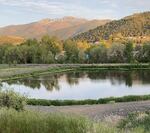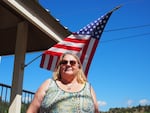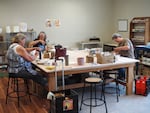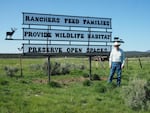
A view of the Strawberry Mountains from Davis Creek Park in John Day, Oregon, on Tuesday, May 23, 2023.
Gemma DiCarlo / OPB
No matter how you look at it, Grant County – five hours southeast of Portland – is a deeply divided place.
There are more than three times as many registered Republican voters in the county as Democrats, a sharp contrast to the Portland metro region or the Democratic majorities in the Oregon Legislature.
Tensions have long simmered between local officials and federal land managers. Most recently, the Grant County Sheriff arrested a burn boss in the Malheur National Forest last fall after a prescribed burn jumped to private land.
And two years ago, 62 percent of voters passed a measure that requires county officials to discuss the idea of leaving Oregon to join Idaho three times a year.
Even so, the county’s several small towns bear the hallmark of many rural communities: everyone knows everyone, and people look out for their own.
“We have the most giving people, I feel like, of anywhere,” said Kim Randleas, board president of the Painted Sky Center for the Arts in John Day. “I haven’t lived in a lot of different places. But if there’s any fundraisers for anything, people are pouring out thousands and thousands of dollars — and we don’t have a lot of high income people here.”
These competing influences play out in nuanced ways across nearly every sector of the community, from politics and industry to arts and culture.
‘Us and them’
Sarah Brown sees the divisions every day in her work as a peer support specialist for Community Counseling Solutions, which provides mental and behavioral health services for Grant County.
“There’s definitely an ‘us’ and ‘them’ mentality,” she said. “It’s such a small community, and everyone’s up in everyone’s business.”
Brown said the stigma around addiction in rural areas can make getting clean an even lonelier experience than in urban areas. The county’s lack of wraparound services, especially housing, can also complicate recovery.
“It’s nearly impossible to get sober if you’re living on your drug dealer’s couch,” Brown said. “There’s not the supports that there are in bigger cities. If you’re going to get sober, you’re going to likely be alone.”
A shortage of master’s-level counselors and clinicians in rural areas can mean long wait times for appointments and other barriers to accessing services.
Brown herself is studying for a master’s degree and plans to move out of her current position at CCS one day. But she doesn’t plan to leave John Day.
“In my experience, there’s loads of opportunity here,” Brown said. “I’ve lived in bigger cities and I feel like I was lost in the crowd. Here, I can make a significant difference — a noticeable difference.”
Two Oregons

Sandie Gilson, the Grant County captain of Citizens of Greater Idaho, poses in front of the Grant School District Offices in Canyon City, Oregon, on Tuesday, May 23, 2023. The group wants to see rural Eastern Oregon split from the state and join Idaho instead.
Dave Miller / OPB
For some in Grant County, the divisions between Western and Eastern Oregon appear too pronounced to overcome.
In 2021, residents passed a ballot measure that requires county officials to discuss becoming a part of Idaho three times a year. The measure passed with 62 percent of the vote.
Sandie Gilson is the Grant County captain of Citizens of Greater Idaho, which has promoted the idea of a split across 14 counties in Central and Eastern Oregon. She said the policies passed by Oregon legislators, such as minimum wage hikes and the Corporate Activity Tax, don’t take into account the needs and means of rural residents.
“Oregon used to be rural-based,” Gilson said. “It isn’t anymore. And we’ve lost the rural base of Oregon to be overridden by the urban-base population.”
With the current legislative makeup in Salem, she said there doesn’t appear to be a way for lawmakers from opposite sides of the state to collaborate.
“There is no longer a compromise or a work between the two sides,” Gilson said. “You hear from everyone, from our president to our Senate leaders and to our governor, ‘No, this is what we’re going to do and we don’t care what you have to say.’”
Shelley Wyllie is a leader of a movement members are calling Oregon Together, which opposes the idea of a split and is based in Grant County. She said she understands the sentiment that rural needs aren’t being addressed, but is concerned that the idea of moving the state border has gained traction among some residents.
“I think what’s at stake is the core issue of the people of Eastern Oregon feeling like their voices aren’t being heard,” she said. “I think they have not given much thought to the consequences of what [leaving] would mean for their families and their lifestyle.”
Wyllie said that Idaho doesn’t provide comparable state-funded health care, infrastructure or education measures.
She said the two parts of the state also share similar issues, such as a lack of affordable housing. Those commonalities, Wyllie said, should be state leaders’ focus.
“We need our state legislators and our local representatives, the county courts, to begin to facilitate conversations of collaboration and let every voice be heard,” she said. “I think we need to have every voice heard with dignity and we need to have constructive conversations.”
Connecting through art

Community members work in the ceramics studio at the Painted Sky Center for the Arts in John Day, Oregon, on Monday, May 22, 2023. The center opened in 2018 as a way for artists in Grant County to connect and collaborate.
Dave Miller / OPB
At the Painted Sky Center for the Arts, politics takes a back seat to community.
The center opened in 2018 as a place for Grant County artists to meet and collaborate. It now offers classes in painting, ceramics, leatherworking and more, as well as after-school programming and workshops with visiting artists.
Board president Kim Randleas said the center was intentionally built as a space for residents to leave their differences aside.
“That’s been a core philosophy of ours — that you come in, make art, and it doesn’t matter who your neighbors are or what they do or what’s going on in your world,” Randleas said. “That philosophy, I think, has brought so many people to the art center and created more community.”
The center also serves as an important creative outlet in an area without amenities like art galleries or movie theaters.
“When you’re in the city, you have so many opportunities to see the arts,” said Genevieve Paddock, a ceramics instructor at the center. “Here, in this rural community, it’s really a homegrown effort. We have to create our own arts and culture.”
Randleas said that residents, county and city leaders immediately stepped up to help create that culture through donations and word-of-mouth outreach. Their support, she said, is the reason Painted Sky has flourished.
“This type of organization couldn’t have come from anywhere else,” she said. “We set our minds to having this great place where there’s a spot for everyone… and we’re gaining more and more people’s confidence in what we can do.”
Managing for the future

Fourth-generation cattle rancher Jack Southworth stands in front of a sign on his property in Seneca, Oregon, on Wednesday, May 25, 2023. Southworth has been practicing holistic land management since the 1980s.
Dave Miller / OPB
Fourth-generation cattle rancher Jack Southworth has been practicing holistic management on his land in Seneca since the 1980s.
He planted willows to restore the streams on his property, planned grazing to maintain healthy pastures and adjusted employment practices to improve quality of life for people who work on the ranch.
Those decisions have led to a more robust ecosystem and more productive land, he said. But on a family ranch, they weren’t always easy to implement.
“I’m in charge, but my dad’s still out here every day,” Southworth said. “He [would say], ‘You and your holier-than-thou grazing and your less-than-savory management!’”
His father wasn’t alone in his assessment of Southworth’s management practices. But Southworth said the number of ranchers taking a more holistic look at the industry is growing.
“We make critical decisions around a stove and a shop,” he said. “I hope that continues on family ranches across the West, because it’s the people that have a close relationship to the land that I think take the best care of it.”
Southworth also works with the National Forest Service during the summer, when his herds move out of the pastures and onto NSF lands to graze.
In the past, cattle were turned loose in the forest with little supervision. But these days, herders make sure they don’t overgraze riparian areas or interfere with campers.
“We understand that that’s not our land. We use it at the courtesy of the Forest Service,” Southworth said. “The Malheur National Forest may have as important a role to play today as a place to seek solitude as it is a place to produce beef, and we recognize that.”
Southworth said collaboration between competing interests will be key to the state’s future — and that the diversity of interests is one of its greatest strengths.
“I like being part of Oregon. I think that we have these differences, but I think we’re going to figure them out,” Southworth said. “We need a different context for solving problems in the West. It’s going to [involve] more of that collaboration, which isn’t fun, but I think it produces the best long-term solutions.”
